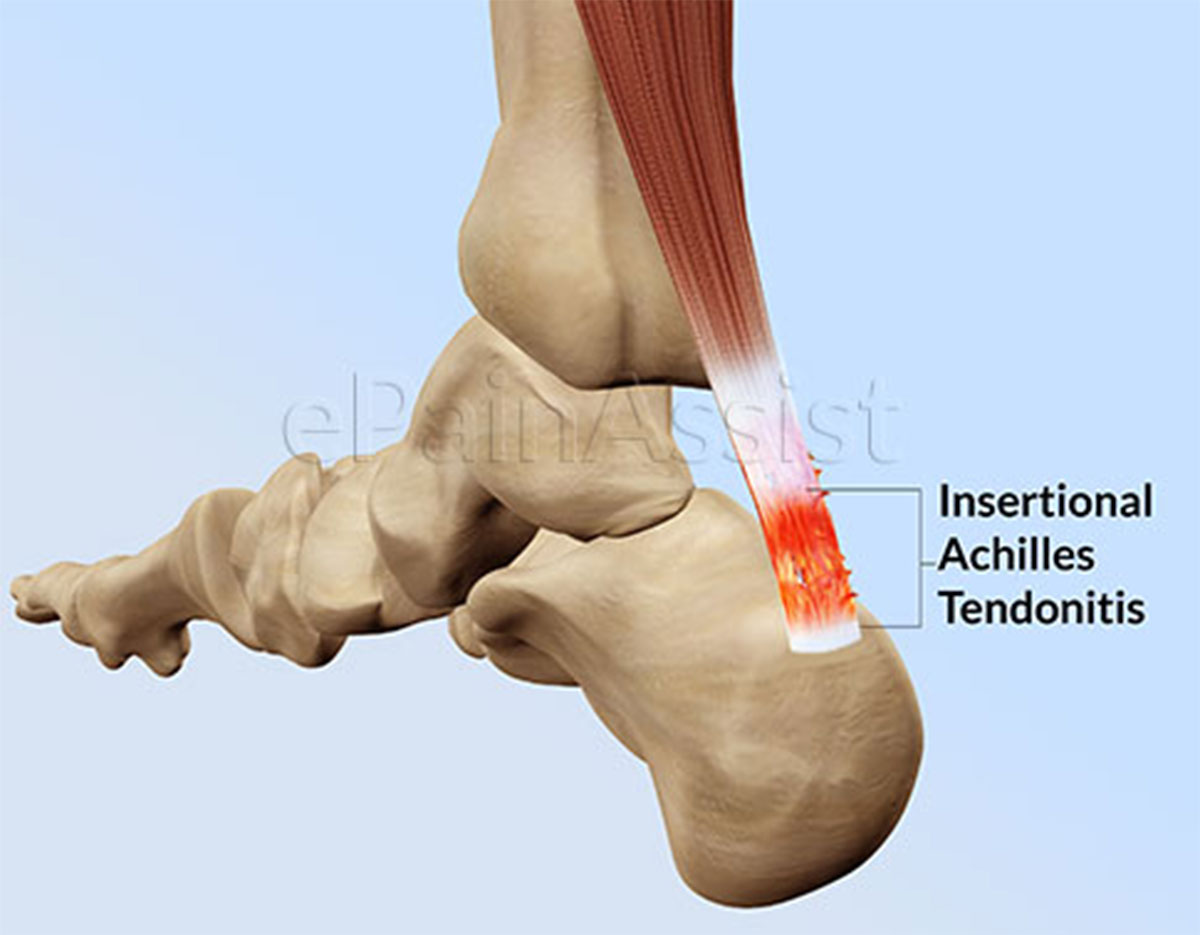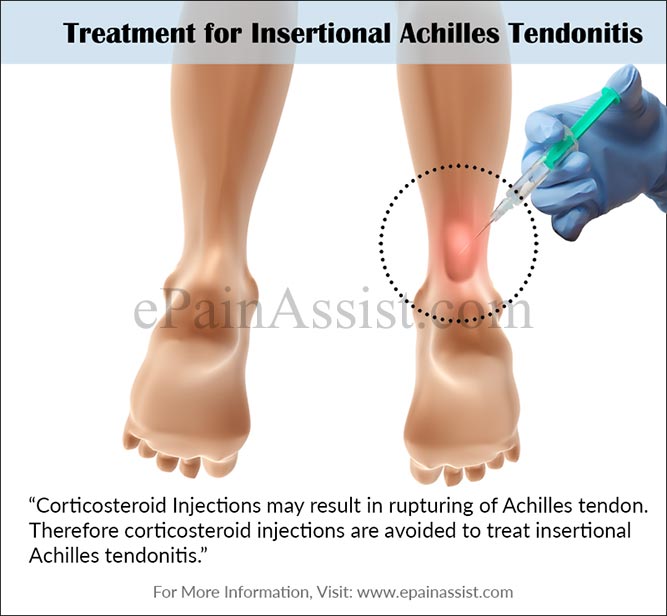What Is Insertional Achilles Tendonitis?
Insertional Achilles Tendonitis is a condition which involves gradual degradation of the Achilles tendon at its meeting point of the calcaneus or heel bone present in the foot. Insertional Achilles tendonitis causes inflammation, swelling, and pain in the heel. Aged individuals participating in repetitive high-impact activities such as running and hill climbing often get affected with insertional Achilles tendonitis. Overweight individuals are also more prone to get affected with insertional Achilles tendonitis.

Insertional Achilles tendonitis often occurs with gradual or sudden onset resulting in swelling and chronic posterior heel pain forcing the back of the heel to become puffy, tender and also making it intolerable to wear shoes with a heel and back.
Increased physical activities such as running and walking and stress resulting from shoe gear often leads to aggravation of pain. A bony prominence is appreciated most of the times both medially as well as laterally at the insertion of the Achilles tendon.
Causes and Risk Factors of Insertional Achilles Tendonitis

- Insertional Achilles tendonitis is caused due to the pain and inflammation around the joining point of the heel and Achilles tendon.
- Excessive stress at the connecting point of the heel and tendon during movements.
- Excessive stretching of the tendon.
- Repetitive high-impact sports may produce severe inflammation or sometimes may even lead to rupturing and tearing of the tendon.
- People who participate in physical activities particularly those of a repetitive nature like dancing and running often get affected with insertional Achilles tendonitis.
- Overweight people in the age group of 50 to 60 years may also get affected with insertional Achilles tendonitis.
- Insertional Achilles tendonitis may also lead to gradual development of thickening and hardening of the tendon which may also increase the chances of rupturing or tearing of the tendon.

Signs and Symptoms of Insertional Achilles Tendonitis
- Tenderness over the Achilles tendon insertion region or at the meeting point of the tendon and bone around the back side of the heel.
- Patient may also experience discomfort at the time of repetitive movements.
- Progressive inflammation may also lead to constant tenderness and severe discomfort.
- Decreased range of motion of the ankle joint.
- Swelling and pain at the Achilles tendon insertion at the back of the heel bone.
- Exacerbation of pain is also experienced while running and jumping.
- Stiffness behind the ankle joint may also be experienced.

Treatment for Insertional Achilles Tendonitis
- Conservative Treatment: Insertional Achilles tendonitis in many cases can be treated just like any other inflammatory disorder. A combination of icing, medication, and rest is often enough to treat insertional Achilles tendonitis. Treatment for insertional Achilles tendonitis initially concentrates on decreasing the stress on affected region. Wearing open-backed shoes like clogs, mules, flips-flops, and sandals helps in reducing the pressure on the heel bone. Non-steroidal anti-inflammatory drugs, steroids and different physical therapy modalities like stretching and ultrasound are recommended. Nitroglycerin patches help in increasing the blood supply in the affected region.
- Physical Therapy: Arch supports, heel lifts and night splints are also used in case of persistence of symptoms. Brace or cast is applied only when this fails to work appropriately.
- Corticosteroid Injections may result in rupturing of Achilles tendon. Therefore corticosteroid injections are avoided to treat insertional Achilles tendonitis.
- Surgical Treatment: Surgery is performed only when conservative treatment fails to work appropriately. Surgery is performed to remove degenerated portion of the tendon, bone that irritates the tendon and also the inflamed bursa tissue. Lengthening is also required in case of short tendon. Strengthening of the tendon attachment at the heel bone may be required with sutures.
A splint is worn after surgery in a toe down position to aid in wound healing. Weight bearing and range of motion exercises may be started once the wound begins to heal. Physical therapy may be started after four to six weeks of surgery. It may take about 8 to 12 weeks after surgery to return to athletic activities depending on the severity of the tendon detachment and may take longer if tendon transfer is required at the time of surgery.
Investigations for Insertional Achilles Tendonitis
Generally a complete subjective and physical examination is performed to diagnose insertional Achilles tendonitis. Typically an x-ray is required for confirming the severity. Other tests may include MRI.
Insertional Achilles Tendonitis Recovery Time and Exercises
As we all know that Achilles tendon injuries can feel like it will never go away. They are extremely painful and can even send you into depression due to nonhealing of the condition. Read further to know how long does it take to recover from Insertional Achilles Tendonitis and what are the exercises that can be done for speedy recovery.
Now about the question as to how long does it take to recover from Insertional Achilles Tendonitis, under normal circumstances it takes about 10 to 12 weeks before the sportsman can return to active training but not before undergoing a thorough physical therapy and exercise regimen which is mentioned below.
Normally, the physical therapist may recommend calf stretching to make the calf muscles loose and increase the range of motion of the ankle but studies show that this is more harmful than it does good to the sportsman and may even delay return to active sports. In lieu of that the best form of exercises to get rid of Insertional Achilles Tendonitis is eccentric heel drop exercises.
Below, we have shown how this exercise is done in detail.
This protocol of exercises consists of two forms of exercises which is doing exercises with the knee straight and doing exercises with the knees bent. These exercises should be done in sets of three of 15 heels drops and should be done twice a day for about 10 to 12 weeks.
Initially, while doing these exercises you may feel some increase in pain but gradually the pain is relieved as the injury heals; however, if you are not able to tolerate the pain then you should stop doing the exercises. Once you are able to do these exercises without any pain then slowly you can also add weights to increase resistance. There are three forms of exercises which are mentioned below.
Insertional Achilles Tendonitis Exercise #1: This exercise is called the Straight-Knee Eccentric Heel Drop. To do this exercise, stand near a stair and try and climb the stair using the injured leg which in this case is the left leg followed by the uninjured right leg. This will initially cause some pain and discomfort but gradually the pain will quiet down this. Once this exercise can be done pain free then try using a backpack as a form of increasing the body weight and then do the exercise.

Insertional Achilles Tendonitis Exercise #2: This is called the Bent Knee Eccentric Heel Drop. This is similar to the first exercise but in this exercise bend the leg just a little bit and slowly put the body weight on the injured leg by bending down ever so slightly. If you can do this without any pain then try adding extra body weight by carrying a backpack or something.

Insertional Achilles Tendonitis Exercise #3: This exercise is called the Flat-Ground Eccentric Heel Drop. This is by far the best exercise for Insertional Tendonitis. To do this exercise stand on the tip of the injured leg on a flat ground while using the hands and holding on to a wall for balance and lift the uninjured leg, so that the whole body weight falls on the injured leg. Once you can do it pain free, try adding some weight.

